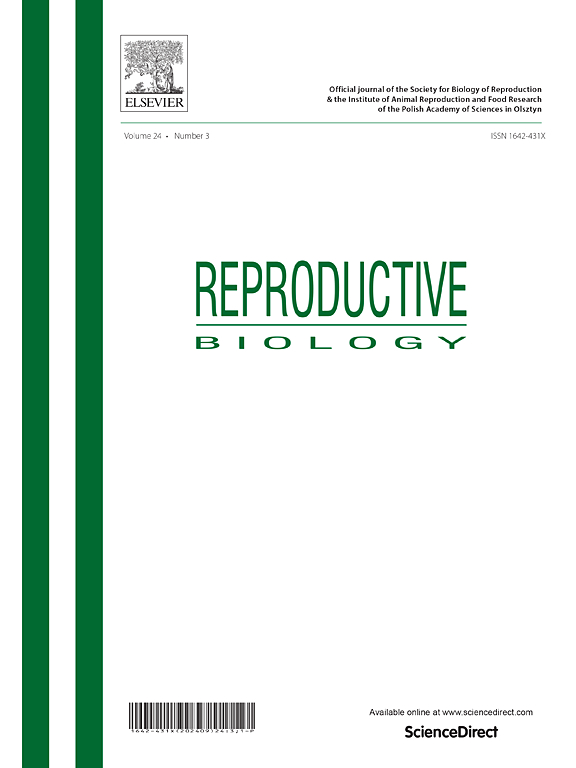Obesity, ovarian GLUT4 expression, and reproductive dysfunction: Insights from Zucker fatty rat
IF 2.5
3区 生物学
Q3 REPRODUCTIVE BIOLOGY
引用次数: 0
Abstract
The impact of obesity on female reproductive health is considerable; despite the well-established association between nutritional status, obesity, and reproductive health, the mechanisms through which obesity impacts the reproductive axis remain poorly understood. For this reason, this study aims to investigate the expression of protein glucose transporter 4 (GLUT4) in the ovary and their association with morphophysiological alterations in the ovaries and uterus in a genetic obesity model, the Zucker fatty (fa/fa) rat. Various parameters were evaluated, including zoometric and metabolic measurements, estrous cyclicity, ovulation, and follicular development. The ovaries and uterus were histologically analyzed using hematoxylin-eosin staining. Furthermore, ovarian GLUT4 protein levels were estimated by Western blotting and fluorescence microscopy to investigate its association with metabolic and reproductive dysfunctions observed in this model. Zucker fatty rats exhibited significant body weight and adiposity index increases, accompanied by elevated cholesterol, triglycerides, and insulin levels. Conversely, progesterone levels were found to be significantly reduced. Histological analysis of ovarian morphology revealed pre-cystic follicles, a diminished follicular population, and a reduced number of corpora lutea. Additionally, a decrease in ovarian GLUT4 protein expression was observed. The uterine analysis demonstrated a smaller overall area, with notable reductions in both endometrial and myometrial thickness and fewer uterine glands. These findings indicate that in Zucker fatty rats, decreased ovarian GLUT4 protein expression and impaired glucose homeostasis are strongly associated with significant morphological alterations in the ovaries and uterus.
肥胖、卵巢GLUT4表达和生殖功能障碍:来自Zucker肥胖大鼠的见解
肥胖对女性生殖健康的影响相当大;尽管营养状况、肥胖和生殖健康之间已经建立了良好的联系,但肥胖影响生殖轴的机制仍然知之甚少。因此,本研究旨在研究蛋白葡萄糖转运蛋白4 (GLUT4)在遗传性肥胖模型Zucker fatty (fa/fa)大鼠卵巢中的表达及其与卵巢和子宫形态生理改变的关系。评估了各种参数,包括动物测量和代谢测量,发情周期,排卵和卵泡发育。采用苏木精-伊红染色对卵巢和子宫进行组织学分析。此外,通过Western blotting和荧光显微镜检测卵巢GLUT4蛋白水平,以研究其与该模型中观察到的代谢和生殖功能障碍的关系。Zucker脂肪大鼠表现出显著的体重和肥胖指数增加,并伴有胆固醇、甘油三酯和胰岛素水平升高。相反,孕激素水平明显降低。卵巢形态的组织学分析显示囊前卵泡,卵泡数量减少,黄体数量减少。此外,卵巢GLUT4蛋白表达降低。子宫分析显示整体面积较小,子宫内膜和子宫肌层厚度明显减少,子宫腺体减少。这些发现表明,在Zucker脂肪大鼠中,卵巢GLUT4蛋白表达降低和葡萄糖稳态受损与卵巢和子宫的显著形态改变密切相关。
本文章由计算机程序翻译,如有差异,请以英文原文为准。
求助全文
约1分钟内获得全文
求助全文
来源期刊

Reproductive biology
生物-生殖生物学
CiteScore
3.90
自引率
0.00%
发文量
95
审稿时长
29 days
期刊介绍:
An official journal of the Society for Biology of Reproduction and the Institute of Animal Reproduction and Food Research of Polish Academy of Sciences in Olsztyn, Poland.
Reproductive Biology is an international, peer-reviewed journal covering all aspects of reproduction in vertebrates. The journal invites original research papers, short communications, review articles and commentaries dealing with reproductive physiology, endocrinology, immunology, molecular and cellular biology, receptor studies, animal breeding as well as andrology, embryology, infertility, assisted reproduction and contraception. Papers from both basic and clinical research will be considered.
 求助内容:
求助内容: 应助结果提醒方式:
应助结果提醒方式:


